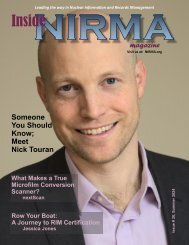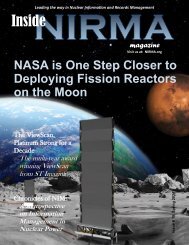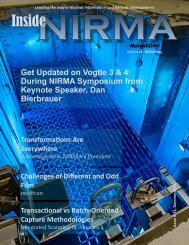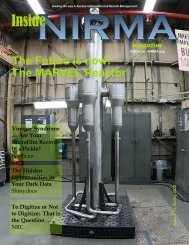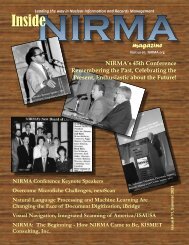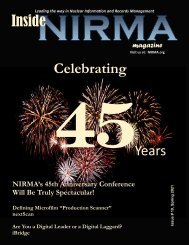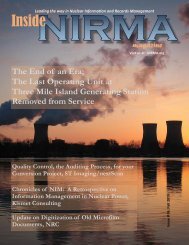Inside NIRMA Fall 2020
You also want an ePaper? Increase the reach of your titles
YUMPU automatically turns print PDFs into web optimized ePapers that Google loves.
Workflow<br />
for a Reason<br />
Understanding the process of<br />
microfilm conversion.<br />
By Matt Anderson,<br />
Vice President of Marketing, nextScan<br />
W<br />
hile you may think microformcapture<br />
is simple: Point,<br />
Shoot, and Capture; TRUE<br />
microform conversion is<br />
complicated. The engineers at nextScan<br />
have decades of combined experience<br />
scanning microforms. Over those years<br />
they have learned to streamline and<br />
perfect the conversion process rather<br />
than cut corners, literally.<br />
First, all data must be captured and<br />
frames must be detected instantly.<br />
When we capture a roll of film we save<br />
it as RAW data allowing for maximum<br />
flexibility during the remaining<br />
operations. Next, a technician audits the<br />
scan to make sure all data has been<br />
Every conversion project is<br />
important, vital even. Your<br />
records are important to us<br />
too. This is why we created a<br />
process that not only scans<br />
your microfilm quickly, but<br />
also delivers perfect images<br />
with all being captured with<br />
complete confidence.<br />
collected properly,<br />
and then makes<br />
any necessary<br />
adjustments before<br />
indexing. And<br />
finally, we create a datafile to deliver a<br />
document when requested. So, why do<br />
we do it this way? When scanning<br />
thousands, or even millions of<br />
microfilm images, you cannot afford to<br />
miss a single one.<br />
One Size Does Not Fit All<br />
nextScan, along with ST Imaging,<br />
make up the microfilm division of<br />
Digital Check, the<br />
world’s leading<br />
manufacturer of<br />
check scanners. Not<br />
only are we experts<br />
in the field of<br />
microform capture<br />
but also check and<br />
other imaging. We<br />
offer many<br />
technologies with<br />
our scanning<br />
solutions, including<br />
Contact Image<br />
Sensors (CIS), Area<br />
Array Cameras, and<br />
Line Scan Sensors.<br />
We use CIS sensors<br />
in our check<br />
scanning products. We offer an Area<br />
Array Camera, which is like the camera<br />
in your cell phone, in our ViewScan 4<br />
microfilm scanner. And we use a Line<br />
Scan Sensor on our high-speed capture<br />
scanners. One image sensor is not the<br />
best solution for all situations. Make<br />
sure you use the right tool for your job.<br />
Advantages of Line<br />
Scanning Technology<br />
For continuous, uninterrupted<br />
scanning of microforms, line scanning<br />
technology is superior. Line scanning<br />
involves precise strobe lighting to allow<br />
the line image sensor to capture every<br />
row of pixels, one at a time, as the film<br />
passes below. This ensures nothing is<br />
missed during the capture process.<br />
And a RAW data file is best for<br />
capturing when using a line scan sensor<br />
because it stores every piece of data as<br />
the microfilm moves beneath the<br />
Continued on next page.<br />
Back to Content | <strong>Inside</strong> <strong>NIRMA</strong> <strong>NIRMA</strong>.org <strong>Fall</strong> <strong>2020</strong> 5



